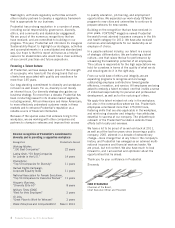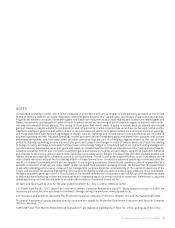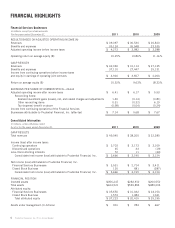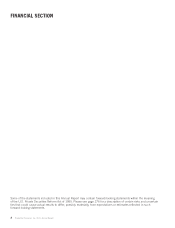Prudential 2011 Annual Report Download - page 13
Download and view the complete annual report
Please find page 13 of the 2011 Prudential annual report below. You can navigate through the pages in the report by either clicking on the pages listed below, or by using the keyword search tool below to find specific information within the annual report.MANAGEMENT’S DISCUSSION AND ANALYSIS OF FINANCIAL CONDITION AND
RESULTS OF OPERATIONS
You should read the following analysis of our consolidated financial condition and results of operations in conjunction
with the “Forward-Looking Statements,” “Selected Financial Data” and the “Consolidated Financial Statements” included in
this Annual Report, as well as the “Risk Factors” included in Prudential Financial’s 2011 Annual Report on Form 10-K.
Overview
Prudential Financial has two classes of common stock outstanding. The Common Stock, which is publicly traded (NYSE:PRU),
reflects the performance of the Financial Services Businesses, while the Class B Stock, which was issued through a private placement and
does not trade on any exchange, reflects the performance of the Closed Block Business. The Financial Services Businesses and the Closed
Block Business are discussed below.
Financial Services Businesses
Our Financial Services Businesses consist of three operating divisions, which together encompass six segments, and our Corporate
and Other operations. The U.S. Retirement Solutions and Investment Management division consists of our Individual Annuities,
Retirement and Asset Management segments. The U.S. Individual Life and Group Insurance division consists of our Individual Life and
Group Insurance segments. The International Insurance division consists of our International Insurance segment. Our Corporate and Other
operations include corporate items and initiatives that are not allocated to business segments, as well as businesses that have been or will be
divested.
We attribute financing costs to each segment based on the amount of financing used by each segment, excluding financing costs
associated with corporate debt which are reflected in Corporate and Other operations. The net investment income of each segment includes
earnings on the amount of capital that management believes is necessary to support the risks of that segment.
We seek growth internally and through acquisitions, joint ventures or other forms of business combinations or investments. Our
principal acquisition focus is in our current business lines, both domestic and international.
Closed Block Business
In connection with the demutualization, we ceased offering domestic participating products. The liabilities for our traditional domestic
in force participating products were segregated, together with assets, in a regulatory mechanism referred to as the “Closed Block.” The
Closed Block is designed generally to provide for the reasonable expectations for future policy dividends after demutualization of holders
of participating individual life insurance policies and annuities included in the Closed Block by allocating assets that will be used
exclusively for payment of benefits, including policyholder dividends, expenses and taxes with respect to these products. See Note 12 to
the Consolidated Financial Statements for more information on the Closed Block. At the time of demutualization, we determined the
amount of Closed Block assets so that the Closed Block assets initially had a lower book value than the Closed Block liabilities. We expect
that the Closed Block assets will generate sufficient cash flow, together with anticipated revenues from the Closed Block policies, over the
life of the Closed Block to fund payments of all expenses, taxes, and policyholder benefits to be paid to, and the reasonable dividend
expectations of, holders of the Closed Block policies. We also segregated for accounting purposes the assets that we need to hold outside
the Closed Block to meet capital requirements related to the Closed Block policies. No policies sold after demutualization will be added to
the Closed Block, and its in force business is expected to ultimately decline as we pay policyholder benefits in full. We also expect the
proportion of our business represented by the Closed Block to decline as we grow other businesses.
Concurrently with our demutualization, Prudential Holdings, LLC, a wholly-owned subsidiary of Prudential Financial that owns the
capital stock of Prudential Insurance, issued $1.75 billion in senior secured notes, which we refer to as the IHC debt. The net proceeds from
the issuances of the Class B Stock and IHC debt, except for $72 million used to purchase a guaranteed investment contract to fund a
portion of the bond insurance cost associated with that debt, were allocated to the Financial Services Businesses. However, we expect that
the IHC debt will be serviced by the net cash flows of the Closed Block Business over time, and we include interest expenses associated
with the IHC debt when we report results of the Closed Block Business.
The Closed Block Business consists principally of the Closed Block, assets that we must hold outside the Closed Block to meet capital
requirements related to the Closed Block policies, invested assets held outside the Closed Block that represent the difference between the
Closed Block assets and Closed Block liabilities and the interest maintenance reserve, deferred policy acquisition costs related to Closed
Block policies, the principal amount of the IHC debt and related hedging activities, and certain other related assets and liabilities.
The Closed Block Business is not a separate legal entity from the Financial Services Businesses; however, they are operated as
separate entities and are separated for financial reporting purposes. The Financial Services Businesses are not obligated to pay dividends on
Closed Block policies. Dividends on Closed Block policies reflect the experience of the Closed Block over time and are subject to
adjustment by Prudential Insurance’s Board of Directors. Further, our plan of demutualization provides that we are not required to pay
dividends on policies within the Closed Block from assets that are not within the Closed Block and that the establishment of the Closed
Block does not represent a guarantee that any certain level of dividends will be maintained.
Revenues and Expenses
We earn our revenues principally from insurance premiums; mortality, expense, and asset management and administrative fees from
insurance and investment products; and investment of general account and other funds. We earn premiums primarily from the sale of
individual life insurance and group life and disability insurance. We earn mortality, expense, and asset management fees from the sale and
servicing of separate account products including variable life insurance and variable annuities. We also earn asset management and
administrative fees from the distribution, servicing and management of mutual funds, retirement products and other asset management
products and services. Our operating expenses principally consist of insurance benefits provided, general business expenses, dividends to
policyholders, commissions and other costs of selling and servicing the various products we sell and interest credited on general account
liabilities.
Prudential Financial, Inc. 2011 Annual Report 11
























